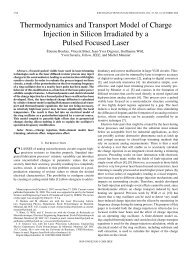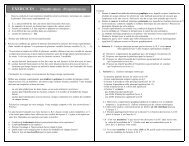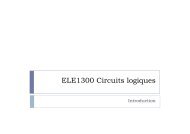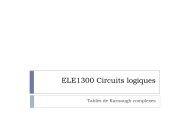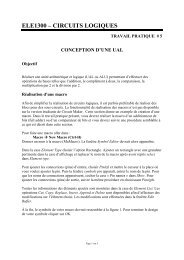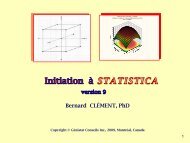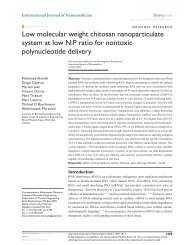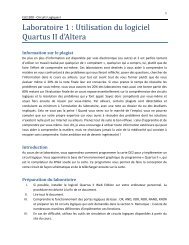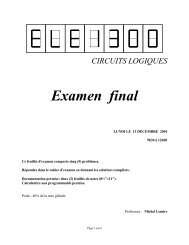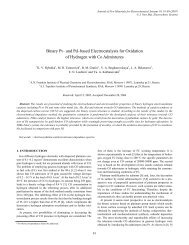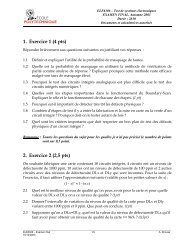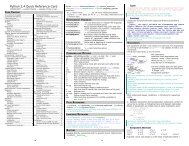Open Full Contents
Open Full Contents
Open Full Contents
Create successful ePaper yourself
Turn your PDF publications into a flip-book with our unique Google optimized e-Paper software.
Journal of New Materials for Electrochemical Systems 9, 353-358 (2006)<br />
© J. New Mat. Electrochem. Systems<br />
New Type of Carbon/Carbon Composite as Anode Material<br />
for High Power Li-ion Cells<br />
∗ J.M. Skowroński 1,2 ,S.Błażewicz 3 , M. Walkowiak 2<br />
1 Poznań University of Technology, Institiute of Chemistry and Technical Electrochemistry, ul Piotrowo 3, 60-965 Poznań, Poland<br />
2 Central Laboratory of Batteries and Cells, ul. Forteczna 12, 61-362 Poznań, Poland<br />
3 Academy of Mining and Metallurgy, Department of Special Ceramics, al A. Mickiewicz 30, 30-059 Kraków, Poland<br />
Received: February 14, 2006, Accepted: May 27, 2006<br />
Abstract: Phenol formaldehyde resin filled with two-directionally arrayed graphite fibers was thermally treated at 2200 ◦ Cin<br />
argon to give carbon-carbon composite plates. Anodes for lithium-ion cells were prepared by both simple cutting out disks electrodes<br />
and milling C/C composite plates followed by mixing the resulting carbon particles with polymer binder. All the powder type anodes<br />
consisted of carbon particles smaller than 32 μm in diameter. A very high cyclic reversibility was reached (94%) for the first cycle<br />
of disk anodes, but discharge capacity appeared to be unsatisfactory. The number increased 2.5 times for anodes composed of milled<br />
composites, whereas their cyclic reversibility persisted unchanged. These anodes exhibited particularly advantageous behavior when<br />
discharged at high rates. Their discharge capacities appeared to be 40% and 19% higher as compared to anodes composed of milled<br />
graphite fibers as well as graphite flakes, respectively. It was shown that the milling operation carried out excessively long exerted a<br />
negative influence on the electrochemical parameters of anodes. The electrochemical results are discussed with respect to XRD and<br />
SEM data.<br />
Keywords: inorganic compounds, nanostructures, electron microscopy, X-ray diffraction, electrochemical properties.<br />
1. INTRODUCTION<br />
Along with the development of the so-called lithium-ion<br />
(rocking chair, shuttle-cock, swing) energy storage technology<br />
at the end of the twentieth century, carbon materials<br />
have found new rich area of application. This is due<br />
to the fact that in spite of intensive investigations, carbons<br />
(especially graphites) are still considered as the best<br />
option for anode materials for Li-ion batteries. Among<br />
carbon materials studied as potential anodes are natural<br />
and synthetic graphites (including their derivatives such<br />
as expanded graphites), graphite fibers, non-graphitized<br />
carbons (both soft and hard), doped carbons, carbon composites<br />
and nanotubes. In spite of the existence of so many<br />
forms of carbon, various kinds of graphite are most commonly<br />
chosen as practical anodes in commercial batteries.<br />
This is caused by certain favorable features of graphites<br />
such as high reversible capacity, relatively low irreversible<br />
capacity, flat voltage profile with the average lithium intercalation<br />
voltage close to zero volts (vs. Li/Li + ). However,<br />
∗ To whom corresponding to: E-mail: jan.skowronski@put.poznan.pl,<br />
Fax: +48 61 665 2571<br />
graphite materials have also a number of disadvantages,<br />
among which the most important are slow lithium ion diffusion<br />
rate and incompatibility with some electrolytes. One<br />
of the ways to improve the electrochemical performance of<br />
graphitic materials is their coating with a layer of unorganized<br />
carbon, and thus creating a carbon/carbon-type<br />
composite. There are roughly two kinds of methods of<br />
achieving this goal. The first one (carbonization methods)<br />
is based on mixing graphite material with carbon<br />
precursor followed by carbonization at a high temperature.<br />
In the second group of methods (vapor deposition<br />
methods), carbon is deposited onto the graphite particles<br />
from vapor phase. The first report on C/C composites<br />
as potential anodes for Li-ion cells comes from the year<br />
1995. In their work Kuribayashi et al. [1] studied materials<br />
obtained by heat treatment of the mixture of various<br />
graphitic materials and pitch blended phenol resins. The<br />
authors classified their composites as core-shell structured<br />
materials. More recently, Liu et al. [2] examined another<br />
material of this type, in which the graphite core was encapsulated<br />
in non-graphitizable coke shell. They found this<br />
electrode material to have excellent characteristics, such as<br />
353
354 J.M. Skowroński et al. / J. New Mat. Electrochem. Systems<br />
high capacity, enhanced kinetics of lithium transport and<br />
compatibility with the electrolyte. Very promising results,<br />
especially in terms of reduced irreversible capacity, were<br />
obtained also by Yoshio et al. [3], who synthesized their<br />
graphite-carbon composite using so-called thermal vapor<br />
deposition technique. There exist reports on carbon fibers<br />
(not graphitized) as the core component in C/C composites<br />
regarded from the point of view of lithium intercalation<br />
[4-7]. Takamura et al. [6] proved that a poor cycleability<br />
of a mesophase carbon fibers (prepared at 950 ◦ C) of a low<br />
crystalline perfection can be considerably improved after<br />
coating with epoxy resin carbon. Recently, Skowroński et<br />
al. [7] showed that the cyclic discharge/charge efficiency<br />
as high as 93% can be attained in the first cycle for PANbased<br />
fibers after coating with pyrolytic carbon at 960 ◦ C<br />
followed by heat treatment at 2200 ◦ C. Up to now there<br />
have been no reports on lithium intercalation into C/C<br />
composites having graphitized fibers as the core.<br />
In the present paper, a new type of C/C composite is<br />
reported as potential anode material for Li-ion cells. The<br />
presented material is produced in an innovatory way by<br />
carbonization method, using graphite fibers as the core<br />
component embedded in the non-graphitizable carbon matrix.<br />
It is shown in this work that graphite fibers undergo peculiar<br />
transformation when heated together with the carbon<br />
precursor. It is suggested that this phenomenon can<br />
be regarded as a general rule which applies to all C/C<br />
composites obtained by carbonization methods (but not<br />
for those obtained by vapor deposition methods) and can<br />
convincingly account for their enhanced rate performance.<br />
2. EXPERIMENTAL<br />
Carbon/carbon composites were obtained from high<br />
modulus graphite fibers (Thornel K-1100) and phenolformaldehyde<br />
resin used as carbon precursor. The first<br />
step in the production of polymer-based composites was<br />
the formation of a single layer prepreg with unidirectional<br />
arrangement of fibers infiltrated with the solution of<br />
phenol-formaldehyde resin in ethanol. The prepregs were<br />
air dried at 50 o C under vacuum, to remove the solvent.<br />
Next, appropriately cut layers of the unidirectional fiber<br />
prepreg were put into the form, pressed and cured at about<br />
160 o C. Compression molding was accomplished by placing<br />
the preform into a matched die preheated up to 90<br />
o C. By stacking prepregs in two directions, 2D composites<br />
were obtained. These samples were carbonized at 1000<br />
o C followed by heat treatment up to 2200 o Cinanargon<br />
atmosphere. In the resulting C-C composite the content<br />
of phenol resin-based hard carbon was 30 %. This composite<br />
(denoted K-1100/ZF) was milled gently (sample K-<br />
1100/ZF-R32) in an agate mortar and intensively (sample<br />
K-1100/ZF-M32) during 6 h in a mortar grinder ‘pulverisette<br />
2’ (Fritch). For comparison, the graphite fibers<br />
were examined both in the original state (sample K-1100)<br />
and intensively milled (sample K-1100/M32). All milled<br />
materials were sieved so that they consisted of particles<br />
Figure 1. First cycle of constant current charge/discharge<br />
test at 10 mA/g for the sample K-1100/ZF.<br />
below 32 μm only. The results obtained on the above<br />
materials were compared with those for graphite flakes<br />
(Graphitwerk Kropfmühl AG, 99.98 wt.% C) smaller in<br />
diameter than 32 μm (sample GK32).<br />
The XRD measurements were carried out using X-<br />
ray diffractometer (Phillips PW-1710, 35kV, 20mA) with<br />
FeKα radiation (λ = 0.1937 nm). SEM images of examined<br />
materials were obtained using the scanning electron<br />
microscopy (Tescan - Vega 5135).<br />
The lithium insertion/deinsertion behaviour of samples<br />
were examined in a two electrode coin cell (CR 2430-type )<br />
with a lithium foil playing simultaneously the role of both<br />
the counter and reference electrode. The electrolyte was<br />
1M LiClO 4 - EC/DEC (1:1 by weight). The working electrodes<br />
(except for K-1100/ZF in case of which electrodes<br />
were prepared by simple cutting round pellets out of the<br />
original plate) were prepared by mixing the sample (90<br />
wt.%) with PVDF (10 wt.%) dissolved in cyclopentanone.<br />
After spreading the slurry on the nickel grid current collector<br />
the electrodes were dried under vacuum at 140 ◦ Cfor<br />
4 hours. The cells were assembled in glove box filled with<br />
dry argon and then galvanostatically cycled between 0 V<br />
and 2 V vs. Li/Li + . For each cell five charge/discharge cycles<br />
were done at the rate of 10 mA/g of active substance,<br />
followed by additional three cycles at the rate of 30 mA/g,<br />
followed by additional three cycles at the rate of 100 mA/g.<br />
3. RESULTS AND DISCUSSION<br />
The composite carbon material examined in the present<br />
work is produced in a form of hard, brittle plates having<br />
ca. 1 mm in thickness. Although the fibers are sunk in the<br />
hard carbon matrix, the fibrous morphology of the material<br />
can still easily be seen. To obtain the electrochemical<br />
data on the composite as-received, the electrodes were prepared<br />
by simple cutting the round pellets out of the plates,<br />
and then testing them in a coin cells with metallic lithium<br />
as counter-electrodes. The galvanostatic curve for the first
New Type of Carbon/Carbon Composite as Anode Material for High Power Li-ion Cells<br />
/ J. New Mat. Electrochem. Systems 355<br />
Table 1. Electrochemical parameters of examined materials.<br />
Sample<br />
10<br />
Q 1ch<br />
10<br />
Q 1dis Irr. Eff.<br />
30<br />
Q dis<br />
Capacity<br />
Capacity<br />
30 30<br />
dropQ dis Q 100<br />
dis dropQ dis<br />
10 10<br />
vs.Q 1dis vs.Q 1dis<br />
[mAh×g −1 ] [mAh×g −1 ] [mAh×g −1 ] [%] [mAh×g −1 ] [%] [mAh×g −1 ] [%]<br />
K-1100/ZF 99 93 6 94 30 68 − −<br />
K-1100/ZF-R32 240 220 20 92 205 7 142 35<br />
K-1100/ZF-M32 248 204 44 82 174 15 89 56<br />
K-1100 301 272 29 90 229 16 100 63<br />
K-1100-M32 335 293 42 87 214 27 47 84<br />
GK32 369 342 27 93 291 15 102 69<br />
Q 10 1ch : Charge capacity in the first cycle of constant current test at 10 mA/g<br />
Q 10 1dis : Discharge capacity in the first cycle of constant current test at 10 mA/g<br />
Irr.: Irreversible capacity in the first cycle defined as Q 10 10<br />
1ch -Q 1dis<br />
Eff.: Efficiency in the first cycle defined as (Q 10 1dis /Q 10 1ch )*100<br />
Q 30 dis : Discharge capacity in the third cycle of constant current test at 30 mA/g<br />
Q 100 dis : Discharge capacity in the third cycle of constant current test at 100 mA/g<br />
Figure 2. SEM image for the sample K-1100/ZF-R32.<br />
Figure 3. SEM image for the sample K-1100/ZF-M32.<br />
cycle can be seen in Fig. 1, and the relevant numerical<br />
data is given in Table 1 (sample K-1100/ZF). Small values<br />
of the first charge and discharge capacities (99 mAh/g<br />
and 93 mAh/g, respectively, at 10 mA/g) allow the conclusion<br />
that not the whole of sample is accessible for lithium<br />
intercalation, even at such a small charge/discharge rate.<br />
Theshapeofthecurves,whichischaracteristicofdisordered<br />
carbons rather than of graphitic ones (the lack of any<br />
signs of the stage structure, a relatively large hysteresis betweenthechargeanddischargecurves)indicates,thatthe<br />
carbon shell of the composite is preferably accessible for<br />
lithium insertion, whereas the graphite fiber core remains<br />
non-intercalated. This is not surprising taking into account<br />
that the electrode is rather thick and thus the transport<br />
conditions for lithium ions are aggravated. Moreover, the<br />
exceptionally small value of the irreversible capacity loss<br />
(6 mAh/g; see Table 1) means that the surface area accessible<br />
for electrolyte penetration is very low which goes well<br />
with the above mentioned observations.<br />
In order to improve the electrochemical performance of<br />
the examined material in terms of enhanced lithium intercalation<br />
conditions, it was decided to transform it to a powder<br />
form. The pulverization of sample was carried out in<br />
two ways: (a) manually in a mortar (mild/non-destructive<br />
pulverization; sample K-1100/ZF-R32) and (b) automatically<br />
in a mortar grinder (intensive/destructive pulverization;<br />
sample K-1100/ZF-M32). To understand the changes<br />
in structure and morphology of the samples subjected to<br />
mild and intensive powdering, the scanning electron microscopy<br />
images were taken and XRD measurements were<br />
done. SEM images made for samples K-1100/ZF-R32 (Fig.<br />
2) and K-1100/ZF-M32 (Fig. 3) reveal that the compositepowderedinamortargrinderismuchmoreefficiently<br />
pulverized as compared to the sample powdered manually.<br />
In the latter case relatively large blocks of carbon are still<br />
visible as well as fragments of fibers having maintained to<br />
a large extent their original fibrous morphology. In contrast<br />
with this, SEM image for sample K-1100/ZF-M32
356 J.M. Skowroński et al. / J. New Mat. Electrochem. Systems<br />
Table 2. Crystallographic parameters of examined materials.<br />
Sample d [nm] L C [nm]<br />
K-1100/ZF-M32 0.3380 43<br />
K-1100/ZF-R32 0.3385 58<br />
K-1100-M32 0.3373 68<br />
K-1100. 0.3365 62<br />
d: Interlayer distance<br />
L C : Crystallite dimension along crystallographic c-axis<br />
Figure 5. XRD pattern for the sample K-1100/ZF-R32.<br />
Figure 4. Enlarged SEM image of a single graphite fibre<br />
in the sample K-1100/ZF-M32.<br />
reveals that this product is much more fragmented, with<br />
poor features of the original morphology. Fig. 4 presents<br />
SEM image made under higher magnification for one fiber<br />
selected from the composite. XRD patterns for both samples<br />
indicate that together with changes in morphology a<br />
significant change in the crystal structure takes place (Table<br />
2 and Figs. 5 and 6). As can be seen for these figures,<br />
the peaks arising for the graphite phase are predominant<br />
on the diffraction patterns. Moreover, it is noteworthy that<br />
the d 002 interlayer spacings calculated based on the (002)<br />
graphite peak for both the milled composites and fibers<br />
are close to each other and similar to that for the original<br />
fibers (Table 2). The broadening of the diffraction peaks<br />
allows the assessment of the structural disorder which was<br />
created in the composites due to their milling. The crystallite<br />
dimension along c-axis (L c ) was calculated on the<br />
basis of the Scherer equation:<br />
0.89λ<br />
L C (002) =<br />
B 002 cos(θ 002 )<br />
where λ isthewavelengthofFeKα radiation, B 002 is the<br />
width at half-maximum of the (002) diffraction peak and<br />
θ 002 is the corresponding diffraction angle. In all case the<br />
(002) peaks were asymmetric in shape, and it was possible<br />
to extract two sub-peaks from the experimental profiles<br />
Figure 6. XRD pattern for the sample K-1100/ZF-M32.<br />
by fitting. However, for the simplicity, the total width was<br />
taken for the determination of the crystallite size. Such values<br />
of L c , although do not possess clear physical meaning,<br />
reflect the existence of the unorganized phase in the samples.<br />
The crystallite size for the sample K-1100/ZF-M32<br />
(43 nm) is smaller in comparison to sample K-1100/ZF-<br />
R32 (58 nm) which means that the crystal structure of<br />
the former sample was destroyed during milling (see Table<br />
2). Intensive milling changes significantly the lithium<br />
intercalation behaviour (see Figs. 7 and 8 and Table 1).<br />
At the current density of 10 mA/g the reversible capacity<br />
for sample K-1100/ZF-M32 (204 mAh/g) is lowered<br />
in relation to sample K-1100/ZF-R32 (220 mAh/g). A<br />
probable reason for this is that prolonged powdering in<br />
a mill introduces some disorder to the sample structure.<br />
It is well known that the presence of turbostratic structure<br />
in graphite makes the lithium uptake in the prepared<br />
electrodes lower. Simultaneously, the irreversible capacity<br />
risesastheeffect of greater pulverisation of the sample be-
New Type of Carbon/Carbon Composite as Anode Material for High Power Li-ion Cells<br />
/ J. New Mat. Electrochem. Systems 357<br />
Figure 7. First cycle of constant current charge/discharge<br />
test at 10 mA/g for the sample K-1100/ZF-R32.<br />
Figure 8. First cycle of constant current charge/discharge<br />
test at 10 mA/g for the sample K-1100/ZF-M32.<br />
cause of increased surface area (44 mAh/g and 20 mAh/g,<br />
respectively). On comparing the galvanostatic curves one<br />
can notice that the shape of curve for sample K-1100/ZF-<br />
R32 is distinctly more “graphitic” in character. On the<br />
curves there exist voltage plateaux characteristic of the<br />
stage transformation. The hysteresis between charge and<br />
discharge curves of the cycle is very small. In the case of<br />
sample K-1100/ZF-M32 this hysteresis is markedly larger.<br />
These observations support the conclusion that too excessive<br />
milling destroys the materials in terms of crystal structure<br />
and electrochemical performance. On the other hand,<br />
mild powdering enhances greatly the material performance<br />
as compared to the original composite plates (compare<br />
data for samples K-1100/ZF and K-1100/ZF-R32 in Table<br />
1), which can be ascribed to the improvement of transport<br />
conditions for lithium ions.<br />
Very interesting observations arise from comparing the<br />
behavior of the studied materials under higher current<br />
rates. It is not surprising that at 30 mA/g and 100 mA/g<br />
all the materials exhibit dramatically smaller capacities<br />
(Table 1). The most pronounced capacity drop is observed<br />
for the original composite (sample K-1100/ZF). On comparing<br />
the figures for mildly and intensively powdered composite<br />
it is particularly striking that the first one shows<br />
much better properties at higher rates in relation to the<br />
second one (35% and 56% capacity drop between 10 mA/g<br />
and 100 mA/g, respectively). For better understanding of<br />
this phenomenon, additional electrochemical experiments<br />
were done. The graphite fibers used for preparing the composite<br />
materials were electrochemically tested both in the<br />
unchanged form (only cut down to ca. 1 mm long pieces;<br />
sample K-1100) and intensively powdered in a grinder using<br />
identical conditions as for the sample K-1100/ZF-M32<br />
(the product is denoted K-1100-M32). Finally, typical<br />
flaky graphite (d < 32 μm) was tested (sample GK32). It<br />
appears from data presented in Table 1 that both graphite<br />
fibers and graphite flakes are characterized by similar and<br />
relatively large capacity drop between 10 mA/g and 100<br />
mA/g (63 % and 69 % respectively). Intensively milled<br />
graphite fibers exhibit even larger capacity drop (84 %).<br />
A very poor rate capability of graphite fibers (both for the<br />
original and intensively milled) in comparison to the composites,<br />
especially those mildly powdered, suggests that<br />
one should search for a factor responsible for a surprisingly<br />
good rate performance of these composites. At this stage<br />
of investigations it might be assumed that the shell carbon<br />
produced by carbonization of phenol resin has so good high<br />
rate capability that even together with such a poor component<br />
as fibers elevates the performance of the resultant<br />
composite. However, this hypothesis might be controversial,<br />
because there is no direct evidence for such excellent<br />
characteristics of phenol resin carbon itself. Besides, the<br />
mentioned characteristics would have to be extraordinarily<br />
good to balance and overcompensate the influence of the<br />
fibers. This view, however, does not exclude the case that<br />
the carbon shell adds certain positive value to the overall<br />
rate performance of the composite since hard carbons are<br />
known to have better abilities to work under higher loads<br />
than graphites.<br />
Another possible explanation is that, apart from a positive<br />
contribution of the carbon shell, also graphite fiber<br />
core undergoes certain positive changes during heat treatment<br />
of the composite. These changes should account for<br />
the enhanced transport conditions in these fibers. Indeed,<br />
after carbonization the fiber surface loses its smoothness<br />
and carbon fibers become brittle in contrast to flexible<br />
fibers used for the preparation of the composites, which<br />
is an observation of a decisive importance. This is due to<br />
phenomena occurring at the fiber/matrix boundary due to<br />
thermal shrinkage of sample resulting in mechanically created<br />
imperfections. Such a view is consistent with reports<br />
evidencing that the stress-induced graphitization occurs<br />
anomalously in the fiber/matrix interface at high temperature<br />
[8,9]. As can be seen in Figure 4, fissures and cracks
358 J.M. Skowroński et al. / J. New Mat. Electrochem. Systems<br />
are present on the fiber surface. Such structural imperfections<br />
may provide paths of fast ionic transport inside<br />
the fiber. The destruction of the core fiber component<br />
upon creation of the composite can be regarded as a very<br />
particular kind of mechanical modification of these fibers.<br />
This beneficial effect is reduced by intensive milling. This<br />
effect is clearly noticed from comparison of the behavior<br />
of pure untreated fibers (sample K-1100) and intensively<br />
milled composite (sample K-1100-M32).<br />
The enhancement of the rate capabilities has already<br />
been reported by some authors for C/C composites obtained<br />
by carbonization technique. For example, Liu et al.<br />
[2] studied lithium insertion/deinsertion behavior of a material<br />
composed of flaky natural graphite as the core and<br />
epoxy resin-derived carbon as the shell. They subjected<br />
their material to constant current charging/discharging<br />
regimes with current densities rising from 0.50 mA/cm 2<br />
up to a maximum of 1.80 mA/cm 2 (which means a 3.6-fold<br />
increase) and found that the composite loses markedly less<br />
of its reversible capacity upon shift to larger loads (60%<br />
capacity drop accompanies a 3.6-fold current density increase)<br />
as compared to the natural graphite (80% capacity<br />
drop in the same conditions). In the present work only 35%<br />
capacity drop is observed upon a 10-fold current density<br />
increase. If one assumes that the essential reason for the<br />
enhancement of rate capability observed for carbonizationtype<br />
C/C composites is mechanical stress inherent to the<br />
carbonization procedure, which is claimed in this work,<br />
then better result presented here for fibers-based composite<br />
in comparison with flakes-based composite presented<br />
by Liu et al. can be explained by the contribution of radial<br />
texture of fiber. Such an orientation of graphite fibers<br />
might promote the formation of cracks along the fiber axis.<br />
This effect is less pronounced for graphite flakes having<br />
plane texture.<br />
From the above considerations one can derive two general<br />
remarks. The first one is that the advantage of vapor<br />
deposition-type C/C composites comes from the fact<br />
that they exhibit decreased irreversible capacities, whereas<br />
the advantage of carbonization-type C/C composites arises<br />
mainly from their enhanced rate capabilities. The second<br />
remark is that the characteristic of the vapor depositiontype<br />
C/C composites is connected directly with the existence<br />
of unorganized carbon layer that screens the edge<br />
planes of the graphite core, whereas the uniqueness of the<br />
carbonization-type C/C composites results from their thermal<br />
history rather than from the actual phase configuration.<br />
It seems that this distinction between the two categories<br />
of C/C composites has not been yet exhaustively<br />
recognized.<br />
4. CONCLUSION<br />
Synthesis of carbon/carbon composite creates new material,<br />
the properties of which are not simply a sum of the<br />
properties of the individual components. In the present<br />
work a new anode material was presented, produced on<br />
the basis of the innovatory carbon/carbon composite having<br />
graphite fiber as the core and phenol resin-base hard<br />
carbon as the shell. At high current loads this material<br />
exhibits exceptionally good capacities, which makes it a<br />
promising anode for high power Li-ion batteries. The results<br />
obtained showed that the loss of discharge capacity<br />
for the C/C composite-based anode due to ten times increased<br />
current density is even twice lower as compared<br />
to that of flaky graphite-type anode. The excellent rate<br />
characteristics of the C/C composite anodes were derived<br />
from the existence of fast ionic diffusion paths in the fibers,<br />
which is likely the consequence of mechanical stress exerted<br />
on the fibers during carbonization.<br />
5. ACKNOWLEDGEMENT<br />
Financial support for this work from the State Committee<br />
for Scientific Research of Poland (KBN Grant No. 3<br />
T09B 068 19) is gratefully acknowledged.<br />
REFERENCES<br />
[1] I. Kuribayashi, M. Yokoyama, M. Yamashita, Battery<br />
characteristics with various carbonaceous materials, J.<br />
Power Sources, 54, 1 (1995).<br />
[2] W.Qiu,G.Zhang,S.Lu,Q.Liu,Correlationbetween<br />
the structure and electrochemical properties of carbon<br />
materials, Solid State Ionics 121, 73 (1999).<br />
[3] M.Yoshio,H.Wang,K.Fukuda,Y.Hara,Y.Adachi,<br />
Effect of carbon coating on electrochemical performance<br />
of treated natural graphite as lithium-ion battery<br />
anode material, J. Electrochem. Soc. 147, 1245<br />
(2000).<br />
[4] S. Yoon, H. Kim, S.M. Oh, Surface modification of<br />
graphite by coke coating for reduction of initial irreversible<br />
capacity in lithium secondary batteries, J.<br />
Power Sources 94, 68 (2001).<br />
[5] M. Saito, K. Yamaguchi, K. Sekine, T. Takamura, Attaining<br />
a long cycle life of Li charge/discharge for less<br />
graphitized carbon by forming a C/C composite, Electrochemistry,<br />
67, 957 (1999).<br />
[6] M. Saito, K. Yamaguchi, K. Sekine, T. Takamura, On<br />
the improvement of Li charge/discharge cyclability of<br />
carbon fibers by making a C/C composite with thermosetting<br />
resins , Solid State Ionis 135, 199 (2000).<br />
[7] J.M. Skowroński, S. Błażewicz, K. Knofczyński, Reversible<br />
insertion of lithium ions into carbon/carbon<br />
nanocomposite, Synth. Met. 135-136, 733 (2003).<br />
[8] Y. Hishiyama, M. Inagaki, S. Kimura, S. Yamada,<br />
Graphitization of carbon fiber/glassy carbon composites,<br />
Carbon 12, 249 (1974).<br />
[9] R.J. Zaldivar, G.S. Rellick, Some observations on stress<br />
graphitization in carbon-carbon composites, Carbon<br />
29, 1155 (1991).



